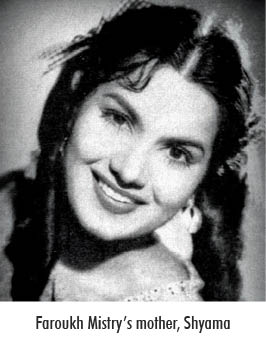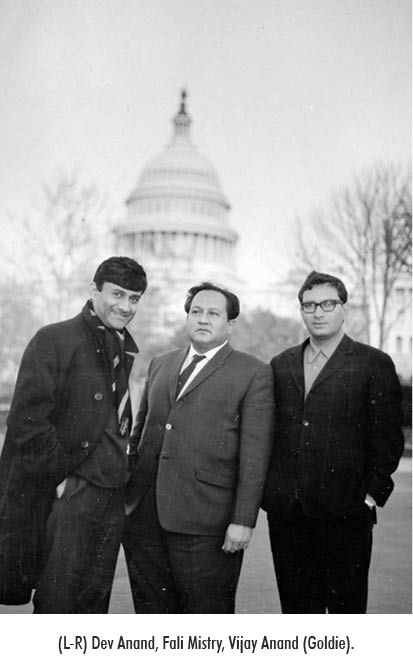 PT: Tell us about your childhood, following in your father’s footsteps.
PT: Tell us about your childhood, following in your father’s footsteps.
Faroukh: Strangely, despite both dad and Jal Kaka being two of the most well-known names in the industry, cinematography wasn’t my preferred vocation. I wanted to be a surgeon. But a chance assignment as a photo-journalist with the Times of India group post my 12th standard exams altered my destiny. Later, I enrolled at the Film and Television Institute of India as the second youngest in my batch, graduating at 24. My growing-up years coincided with my mother’s busiest period in Hindi films. Dad would take us for indoor shoots – the only location filming we were taken to was to Kathmandu for Hare Rama Hare Krishna.
PT: How was the camaraderie between your father and other prominent Parsis like cinematographers – Adi Irani, Jal Ariya, Rustom Irani or his contemporaries – Faredoon Irani, Nariman Irani and others?
Faroukh: Dad would come home after a hard day’s work and make me sit at his feet. He would be on the phone with his colleagues and discuss various filming techniques and other innovative measures they employed. They enjoyed an immensely healthy rivalry and shared a very close rapport.
PT: If I remember right, the entire song ‘Tere mere sapne’ in Guide was filmed in just 2-3 shots!
Faroukh: Yes, in exactly three shots. It was a pioneering effort in those days. He was a favourite with Dev Anand and Vijay Anand. Besides ‘Guide’, he worked for them in ‘Johnny Mera Naam’, ‘Hare Rama Hare Krishna’, ‘Prem Pujari’ and many others.
 PT: How did you land your first feature film?
PT: How did you land your first feature film?
Faroukh: It’s been a long journey. The stepping stone to a feature film is usually via documentaries, TV serials, commercials, and I’ve run the gamut of it all. I’ve shot at least 700 commercials around the world! My first feature film was ‘Jeena Nahin Bin Tere’, directed by Lekh Tandon, in 1990. Unfortunately it barely got a commercial release. My first released feature was ‘Yash’ in 1996.
PT: Tell us about your experiences across both – Hollywood and Bollywood films
Faroukh: In 1991, I did a course at the American Film Institute. That helped me get a thorough insight of the workings there. They are much more disciplined and thoroughly professional. Our cinema is still TV oriented – it suffers from too many dialogues. While watching a Hollywood film, if you switch off the audio, you can still understand the narrative through its visuals. Can you do the same with Indian films? Also, Indian filmmaking is largely outdated – lacking originality and too many remakes.
PT: There’s an ongoing debate between celluloid versus digital format of film making, as also colour versus black-and-white films. What do you think?
Faroukh: While both have their pro and cons, the digital format is here to stay, though celluloid isn’t going to die away. While celluloid film depends on raw stock, its quality is richer, and under optimum conditions, its shelf life could stretch to 200-300 years. Digital film has higher sensitivity to light, its shelf life is considerably low since it depends entirely on digital storage. Do you know that the Toy Story got almost formatted, accidentally? Costwise, there’s not much of a difference.
Colour film is popular with cinemagoers as they want entertainment. But if it’s an ‘art’ film, B&W is the preferred form as it depicts reality minus the distraction of colour. Here too the cost factor doesn’t vary much.
PT: In ‘Angrezi Mein Kehte Hain’, I observed that you have predominantly used mid-shots and avoided closeups. Any particular reason?
Faroukh: You’re right. Firstly, as I mentioned earlier, I didn’t want to get into the typical Indian style of filmmaking with an over-reliance on closeups. I’ve used just two – when Pankaj Tripathi holds his wife’s hand and when Sanjay Mishra quarrels with his wife. Both these situations warranted closeups. And Hoshang, I’ll tell you something – in this film I’ve paid my father a tribute.
PT: In which scene?
Faroukh: Where Mishra wears a red shirt and his wife is in a pink saree. If you recall, in the ‘Guide’ duet ‘Gaata rahe mera dil’, Dev Anand and Waheeda Rehman were similarly clad.
PT: What influences you most whilst accepting an assignment?
Faroukh: Two things – the script and the trust factor between the director and I.
PT: Lastly, who are your ideals, both here and in the West?
Faroukh: (Without hesitating) My first influence undeniably has to be my father. Also V K Murthy, who assisted my father in many films. From Hollywood, it’s Conrad L Hall (American Beauty, Road To Perdition).
- Parsee Gym Retains Supremacy In 7th Late Manek Golvala T10 Cricket Cup - 13 April2024
- Parsee Gym Holds 9th All-Parsee TT Tourney - 6 April2024
- Parsee Gym Holds Gala Jamshedi Navroze Celebrations - 30 March2024
